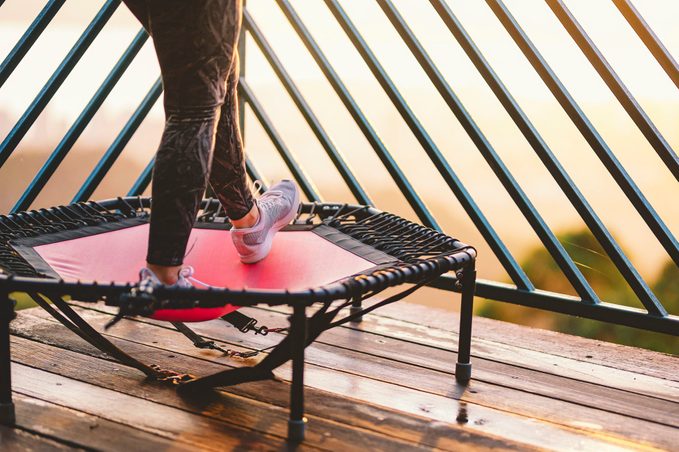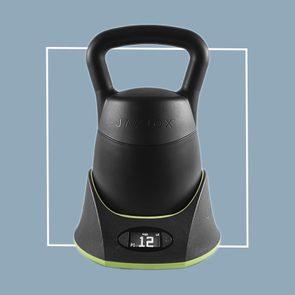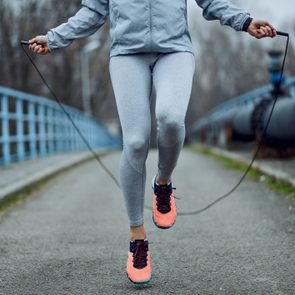I Tried a Rebounder Trampoline for At-Home Workouts and Here’s What It’s Like
Updated: Jul. 28, 2023
A fun workout you can do at home in a small space? Sign me up. Here's what happened when I exercised on a rebounder trampoline—sometimes called a fitness trampoline or mini trampoline—for more than three months.
Our editors and experts handpick every product we feature. We may earn a commission from your purchases.
My experience using a fitness trampoline
For most people, myself included, 2020 was one long stress test. To feel better, I found myself willing to try anything and everything that could reduce my stress levels, as well as improve my mental and physical health, improve sleep quality, and just plain get me through the day.
Some of the experiments ended up being a fail—looking at you Apple Watch I haven’t charged in months. [Opt for these self-care health products for quality “me-time.]
Other products actually did improve my overall health and delivered what they promised [like Vital Proteins Collagen Creamer and Aquis microfiber hair towel]. As part of what I’m calling my very own 15 days of feeling better, I tried working out at home on a rebounder trampoline. Here’s what happened.
What is a rebounder trampoline?
I know the benefits of regular exercise include less illness, lower stress levels, and decreased depression—all things I needed in 2020. But Covid-19 shut down my gym access.
I had to bring my workout home—even though I didn’t have a lot of space for equipment or a ton of money to spend. A Peloton exercise bike just wasn’t realistic for me. Sigh. [Here are the best exercise bikes that won’t break the bank.]
One of my most athletic friends suggested a rebounder trampoline. A rebounder trampoline goes by lots of names: fitness trampoline, mini trampoline, and just plain rebounder. But they are all compact pieces of at-home fitness equipment that can be used to get a good cardiovascular workout at home.
Essentially, rebounders are small (about 40 inches across). They have a firm jumping mat, which allows for a better bounce when compared to those larger kids’ trampolines you might see outdoors. Some are foldable, and they may or may not have a handle or balance bar to grasp when jumping.
Even though a rebounder trampoline is low impact, it doesn’t lack in intensity. By jumping up and down on it, you can get an excellent workout in a small space in your home or apartment.
My first experience with a rebounder trampoline
After researching the most affordable quality rebounder trampoline that was also quiet and small enough to use in an apartment, my friend suggested the Darchen rebounder trampoline. No squeaky springs and a $140 price tag. Sold! It changed my 2020 for the better.
Setting up the rebounder trampoline was pretty simple, though it takes a bit of strength to tightly pull the 30 bungee cords around the circular mat. It makes sense that these are tight. This is where the tension comes in when you start jumping.
Once the rebounder trampoline was set up, I found a YouTube video for beginner rebounders and started jumping. [These are the online fitness classes you should try right now.]
My advice? Go slow, especially if you don’t have a lot of balance or core strength. Ten to 15 minutes of jumping is a lot of cardio.
As I got more comfortable with proper form and the jumping movements, I started to incorporate choreography and small hand weights. Rebounding works every single muscle group in your body, and you can work up a massive sweat in just 30 minutes.
Even more important, I started to have fun working out at home.

How to use a rebounder trampoline
As with any workout routine, form is important. Unlike jumping as high as possible on a giant kids’ trampoline, the goal with a rebounder trampoline is to jump low and into the mat.
“Jumping up and down requires your body to increase oxygen uptake,” says Louis Coraggio, creator of the cult-favorite TrampoLean workout in New York City. “Exertion levels can be elevated by sitting the hips back into a ski-like position.”
That way, you “can apply a great deal of force into each stomp-like motion,” he adds. “The rebounder will then return the exact same force—depending on the quality of the rebounder—and your core muscles will need to work harder to remain low to the mat. Exertion levels can also be achieved by increasing the speed of your bounce rate.”
For best results, “focus on landing on three points of contact on your feet—the heel, big toe, and pinky toe area,” says Coraggio. “Keep your shoulders relaxed and focus on taking breathe in and out through each movement.” [This is the best workout for every age.]
I found that tightening my core with each jump and focusing on where I landed helped improve my technique. If you’re nervous about keeping your balance while getting started, consider a rebounder with a balance bar like this one by JumpSport.
Rebounder trampoline workouts
As for rebounder trampoline choreography and a workout routine, there are multiple ways to get your sweat on. I started by using free YouTube tutorials and learning some basic jumps and choreography like hip twists and scissor kicks. You can also sign up to stream online studio classes that incorporate rebounder trampolines, like LEKFIT and TrampoLean.
Virtual trainers such as FYT Duo will create a personalized routine that uses hand weights and resistance bands on the rebounder trampoline.
Or simply set a timer and jump while you watch TV or listen to a podcast. The beauty of using a rebounder trampoline at home is you can customize the workout from rookie to athlete. [Try a Theragun massage gun for your workout recovery.]
What to wear while rebounding
Athletic shoes or bare feet are both safe for rebounding. Coraggio recommends rebounding barefoot. “Going barefoot increases proprioception (the activation) of more foot muscles,” he says. [These are the best leggings for exercising indoors.]
Lightweight, fitted athletic clothing is best. Avoid wearing jewelry or anything that flies around while jumping (ahem, necklaces).
Women will want to wear a supportive sports bra since the workout involves bouncing and jumping. But there’s no need to focus too much on clothing. I’ve done a quick five-minute jump between meetings while wearing jeans and a blazer.
How long should you rebound every day?
This is truly up to your physical goals, time, and willpower. I rebound for about 20 minutes on weekdays and try to get in a longer session of 30 to 45 minutes on weekends.
Fitness entrepreneur and celebrity trainer, Lauren Kleber, utilizes a rebounder trampoline in her LEKFIT studio and digital class workouts. She advises using a rebounder trampoline as part of a complete workout.
“At LEKFIT, we use the rebounder in an interval series of weights, leg workouts, and core. The length of time for someone to do it at home and see results all depends on various personal elements within the body,” she says.
Benefits of using a rebounder trampoline
One question people usually have: Is rebounding better than running? I personally think rebounding is better than running, just because it’s more fun. So I do it more often. Jumping on a mini trampoline feels less like working out, and more like blowing off steam or playing. And from a professional and studied perspective, rebounding also beats running.
[Jumping rope vs running? Find out which is better.]
A NASA study published in the Journal of Applied Physiology found that rebounding exercise is far more efficient than jogging. A rebounder also takes up way less space than a treadmill. And rebounding can be done at home instead of in public areas where you’ll encounter people.
“Rebounding isn’t (just) a good cardio routine, it’s excellent,” says Coraggio. “If someone applied the similar exertion of running and jumping on a trampoline, the person on the trampoline would burn more calories, increase cardiovascular demands, and strengthen muscles and bones 68 percent more than the person running,” he says, citing the NASA study.
Since rebounding is low impact (the mat—not your joints—absorbs the shock of landing a jump) it’s also good for all ages and reduces stress injuries.
Jumping on a rebounder trampoline has serious internal health benefits, too. A study published in 2016 in the Journal of Sport and Health Science shows it supports bone density and strength.
Another perk of using the rebounder at home? It increases mindfulness.
“As you jump you’re focusing on each land, body awareness, breathing, balance, and spatial awareness,” says Coraggio. “When I get sluggish mid afternoon, five minutes of rebounding to my favorite song goes a long way toward waking me up, feeling energized and focused. It’s a healthier choice than pouring a second cup of coffee or grabbing a sugary snack.” [Check out these natural energy boosters.]
Risks of using a rebounder trampoline
Due to the low impact, really almost anyone can use a rebounder. Of course, you should check with your doctor before beginning any exercise regimen.
“Sometimes in the studio we have clients with ankle issues, and they have to be a little more careful,” says Kleber. For ensuring proper form at home she suggests putting a full-length mirror in front of the rebounder trampoline so you can see yourself jumping.
So, did rebounding make me feel better?
Yes! Rebounding on a rebounder trampoline is easily my favorite at-home workout. I love that I can easily store it while not in use. But usually I just keep it next to my desk so I can jump on for a quick workout and energy boost anytime of day. I look forward to working out on the rebounder, and the time goes fast since I’m focused on jumping and not the clock.
Since I started rebounding, I’ve noticed muscle definition in my legs, glutes, and back—and I’ve lost a few pounds. More importantly, I feel less stressed and sleep better on the days I rebound. When spring hits, I plan on taking my rebounder trampoline outdoors. I don’t even miss the gym.
For more indoor workouts, here are the best home rowing machines for every budget.
















